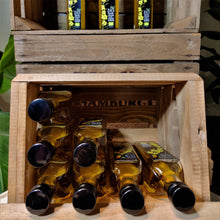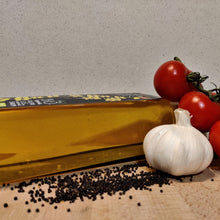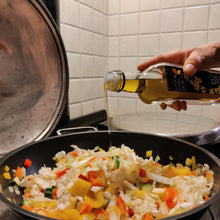
Our cold-pressed canola oil (also called rapeseed oil) has a full flavour with a silky texture and a deep yellow colour (especially compared to mild neutral-tasting oil from high-temperature pressing). Find the nutritional value and how to use canola oil down below.
Arjen and Winny grew this rapeseed together with red clover in two small fields surrounded by mixed flower strips. By combining two crops in one field, crops can complement each other, biodiversity increases and all soil surface is well-covered.
Complete product details
Details
At a glance:
- Cold-pressed
- Rich flavour
- Increases biodiversity
- Long shelf-life
- Size: 250ml
Detailed information:
- Produced in: Lochem, The Netherlands
- Produced by: Arjen van Buuren and Winny van Buuren-Tessers
- Field objective: Intercropping
- Certificates of grower: Organic certified
- Processed by: Van de Klok
- Transport mode to warehouse: Transporter van
- Bulk storage: Stored in kraft carton boxes
- Packaging: Glass bottle with steel cap
- How to recycle: In white glass recycling container
Cooking
Cold-pressed canola oil has a richer flavour profile than industrial high-temperature pressed oils. For deep frying or use in large quantity, it may be better to use a neutral-tasting industry oil. Our Velhorst organic canola oil is however highly suitable for all heating purposes, as a base for sauces or in a dressing.
Nutrition
Canola oil is rich in vitamin K and E (both fat soluble vitamins) as well as omega 3. The oil consists mainly of unsaturated fatty acids and little saturated fatty acids. Saturated fat is seen as bad, whilst unsaturated fat is seen as good. Pure oils that are liquid at room temperature are generally high in unsaturated fatty acids. In the tab sustainability you can read more about different fat types.
This product may contain traces of gluten.
| Nutritional value | Per 100 gram | Per portion (15 g) | RI* | ||
| Energy | 3739 kJ (894 kcal) | 561 kJ (134 kcal) | |||
| Fat | 99.3 | g | 14.9 | g | |
| Of which saturated | 7.3 | g | 1.1 | g | |
| Omega 3 fatty acids | 9.14 | g | 1.4 | g | |
| Carbohydrates | 0 | g | 0.0 | g | |
| Of which sugars | 0 | g | 0.0 | g | |
| Fibre | 0 | g | 0.0 | g | |
| Protein | 0 | g | 0.0 | g | |
| Salt | 0 | g | 0.0 | g | |
| Vitamin K | 71.3 | µg | 10.7 | µg | 95% |
| Vitamin E | 17.5 | mg | 2.6 | mg | 146% |
*Reference intake of an average adult ( 8400 kJ/2000 kcal) per 100gr
Sustainability
Vegetable oil can be harvested from trees or from annual plants in the fields. Palm oil and coconut oil are the two best known oil-producing trees. In the news, there is a negative notion around palm oil in particular. So let's put this straight.
Palm oil is actually the crop that produces the most amount of oil per hectare with over 4 tonnes of oil per hectare, followed by coconut oil with just over 2 tonnes per hectare. The third highest yield from major oil crops is rapeseed with close to 1 ton per hectare. Sunflower and soybean yield 0.6 and 0.4 tonnes of oil respectively. Click here to see a corresponding graph. When looking at it this way, more than 10 hectares of soybean is needed to produce as much as 1 hectare of palm oil. For sunflower, this is close to 7 hectares and for rapeseed 4 hectares. When land is becoming more scarce and forests are being cut down rapidly, we may prefer 1 hectare for palm oil over 10 hectares of soybean. Well... There is another side.
Though the above mentioned is true, the problem some countries (like Indonesia and Malasia) are facing with the palm oil production is the massive areas of forests and wildlife that is replaced by monoculture palm trees. In a monoculture, especially with the use of pesticides, the farmer's goal is to take care of only one crop. If only one crop is to be found in a large area, no animal can find shelter or food. It would be like a city, consisting of nothing else than asphalt or bricks. We wouldn't want to be there either, do we?
Another major difference is the properties of the tree oils and annual plant oils. Palm and coconut together with cacao beans are oils with a large proportion of saturated fatty acids. Whereas rapeseed, sunflower or soybean oil majorly consists of unsaturated fatty acids.
Ekoto tries not to mix itself in scientific debates (as science is only the best method we currently have, but surely not always the confident truth).
So far it seems that science points, generally speaking, to saturated fatty acids as bad fat and unsaturated fatty acids as good fat. (One thing scientists have agreed on is the fact that so-called "trans-fat" is bad for your health, but we will cover that later). So, the oil from palm, coconut and cacao is not really preferable for human consumption, or at least only in limited use.
Then the annual crops that we grow in the open fields can be compared to one and other. With regard to land use for the sole purpose of oil production, we have already made the comparison. Rapeseed is the most efficient. Though in conventional cultivation, rapeseed is heavenly sprayed with artificial chemicals. Luckily Ekoto only sells organic rapeseed oil ;)
Looking solely at the extracted oil is also not fair. Besides the oil, a so-called "oil-press cake" remains and in the case of rapeseed and soybean, this cake is highly desired by farmers to use as animal feed. In the case of soybean, a lot of it is grown for the purpose of animal feed. Feed manufacturers are mainly looking for the protein in the beans and so the oil can also be seen as a by-product. The perspective comes into play here, as it depends a little bit to which nutrient you give the most value really. Protein for animal feed or oil for human consumption. And these little nuances may keep debates infinite.
By now you should have quite an understanding of the sustainability factors on oils. Oh... and of course transport. Well, if you order from within the Netherlands, then our organic rapeseed oil is the closest you can find. If you live abroad and you are comparing us with other suppliers, please try to figure out the geography of production in order to make the best decision. If you cannot find the origin, chances are that is has been produced in Canada, Ukraine, Chech Republic, Romania or other eastern European countries.
Producer
In the east of the Netherlands, in the middle of a beautiful country estate named Velhorst, small diverse fields make up the landscape in which Arjen and Winny produce a wide variety of crops and manage a herd of different farm animals.
The rapeseed was grown together with red clover in two small fields surrounded by mixed flower strips. By combining two crops in one field, crops can complement each other, biodiversity increases and all soil surface is well-covered.
Organic rapeseed has never before been successfully grown on Dutch soils. In conventional practises a lot of pesticides are used to grow rapeseed. But Arjen and Winny cracked the code by undersowing rapeseed with another crop that supports the rapeseed and by creating high biodiversity around the field. High biodiversity means that many different plants and animals live in a certain area. For every variety of plants, a certain selection of insects and wildlife can find habitat and food around it. When increasing the varieties, all other life starts to thrive as well. Also, pests to our cultivated crop will take habitat in the field, but as there is a wide selection of other animals in the field, there are also predators of this pest in the field who will naturally take care of the pest and prevents a mega spread that is often seen in conventional farming practises.









